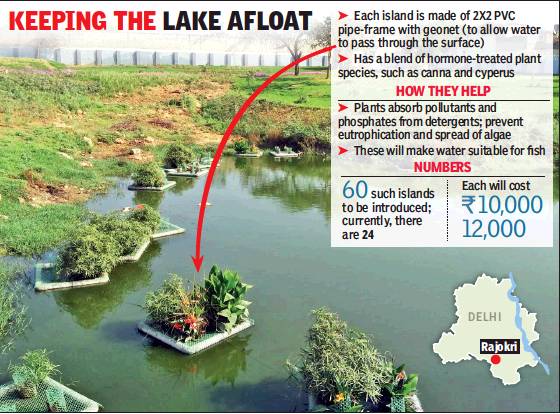Water pollution: India
This is a collection of articles archived for the excellence of their content. |
Solutions
Floating islands on Delhi’s Rajokri lake
Paras Singh, April 4, 2019: The Times of India

From: Paras Singh, April 4, 2019: The Times of India
CLEAN-UP ACT: Hormone-Treated Plants Soak Up Pollutants, Purify Water In Wetland
People living on the periphery of Rajokri lake in the Southern Ridge were bewildered this past week to see green islands floating in the water. Unknown to them, Delhi Jal Board had quietly introduced these “purification islands” to soak up pollutants and purify the water in the wetland that was rejuvenated last year. The islands are knots of hormone-treated plants.
Ankit Srivastava, advisor to DJB, explained that the 2x2-metre rafts have a framework of PVC pipes lined with geonetting to support the plants like cyperus and canna. “A mix of different hormone-treated plants is used on each float to increase the nutrient uptake,” he said. The hormones act as the catalysts for the rapid growth of plants, which feed on the pollutants present in the lake water. This in-house innovation can make water suitable enough to introduce fishes and make the lake ecosystem self-cleaning.
Each raft costs around Rs10,000, including maintenance for a year. Around two dozen such islands have been introduced and DJB plans to have 60 ultimately. The National Environmental Engineering Research Institute created the framework for the floats, but vendors are now manufacturing it. A similar experiment is being carried out at the Hauz Khas lake, where algal bloom has turned the water green.
“The lake at Rajokri was still receiving pollutants like detergent from rainfall and other sources,” a DJB official said. “The plants absorb trace pollutants and the phosphates from detergents, and prevent excess nutrients in the lake leading to algal bloom.”
Besides the floaters, DJB has also given the financial goahead to the addition of two tertiary levels for water flowing from constructed wetland. The Rajokri lake rejuvenation is based on the SWAB technology in which raw sewage feeds the lake after passing through a sedimentation tank, digesters and a gravel-lined zig-zag wetland during which the unwelcome organic matter in the water is reduced to an acceptable level.
“A carbon-sand filter will be added, while on-site aeration units have also been sanctioned. Our aim is to bring the biological quality of the water to levels that will create an ideal environment for fish to flourish,” the official explained. Since December last year, the lake has shown strong signs of recovery, helping groundwater levels rise and attracting birds.